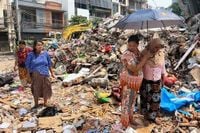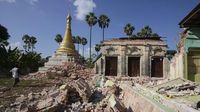On April 13, 2025, a magnitude 5.5 earthquake struck central Burma near Meiktila, situated between the cities of Mandalay and Naypyidaw. This quake is regarded as an aftershock of the catastrophic earthquake that occurred on March 28, which resulted in over 3,600 deaths. Fortunately, authorities reported no new damage or casualties immediately following the April 13 earthquake.
The tremor was felt not only in Burma but also in northern Thailand, where the Meteorological Department confirmed a separate earthquake of magnitude 5.9. This quake occurred at a depth of 10 kilometers at 9:24 AM local time, with its epicenter located 271 kilometers northwest of the Muang district in Mae Hong Son province. Residents in high-rise buildings in Chiang Mai and Chiang Rai reported feeling the earthquake.
Meanwhile, India also experienced seismic activity, with a 3.4 magnitude earthquake recorded in the Mandi district of Himachal Pradesh at 9:18 AM IST, occurring at a shallow depth of 5 kilometers. Authorities confirmed that there were no human or material losses from this quake.
In Tajikistan, two earthquakes struck within an hour, the first being a powerful 6.1 magnitude tremor detected at a depth of 10 kilometers, followed by another measuring 3.9. Fortunately, no major impacts have been reported from these events either.
As the aftershocks continue, the people of Burma are grappling with the aftermath of the devastating March 28 earthquake, which had already left a significant mark on the nation. On this day, thousands of Burmese gathered to mark the beginning of the Thingyan festival, the water festival that celebrates the Burmese New Year. However, the atmosphere was far from festive as the nation mourned the loss of life and the destruction left in the wake of the earthquake.
Despite the traditional rituals of splashing water symbolizing purification and renewal, many residents in Mandalay and Sagaing, areas heavily affected by the March earthquake, faced grim realities. Two weeks post-disaster, hundreds of individuals were still sleeping in tents near collapsed buildings, ruined tea shops, and destroyed hotels.
Many survivors lacked access to functional latrines and were forced to wait in line for drinking water. The threat of heavy rains loomed, raising concerns about the stability of their makeshift homes. Earlier that Sunday, families were seen purchasing clay pots and plants, traditional items to celebrate the New Year, yet the joy was overshadowed by hardship. "Everyone is struggling this year," said Ma Phyu, a 55-year-old woman camping with her family near the royal palace in Mandalay, which had suffered damage in the quake. "I have to prepare the pot with flowers because it's our tradition. But my heart is heavy."
In a poignant reminder of the ongoing crisis, reports emerged of a 4-year-old girl in a displaced persons camp in Mandalay who had stopped speaking since the earthquake. Her mother, Thazin, shared, "Since the earthquake, my daughter doesn’t talk anymore; she is traumatized." They, like tens of thousands of other Burmese, have been sleeping on the streets for over two weeks. In this particular vacant lot, around 400 families, totaling more than 1,500 individuals, live in unsanitary conditions.
Non-governmental organizations (NGOs) have raised alarms about the lack of access to clean drinking water, fearing that the arrival of the monsoon season could lead to outbreaks of disease. The situation is dire, with over 5,200 buildings reported destroyed by the March earthquake, and the United Nations estimating that more than two million people are in need of assistance.
In response to the humanitarian crisis, the UN has launched a call for donations, hoping to raise $275 million to support the affected population. The ongoing civil war in Burma, which has been raging since the military coup of 2021, has further complicated relief efforts. This conflict has led to over 6,300 civilian deaths and displaced more than 3.5 million people, with approximately 50% of the population currently living below the poverty line.
As the country observes the Thingyan festival, the juxtaposition of celebration and sorrow is palpable. The military junta has restricted the festivities, ordering that celebrations occur without music or dance, a stark reminder of the ongoing struggles faced by the population. With temperatures in Mandalay soaring to 44 degrees Celsius since the earthquake, the conditions for those living in tents become increasingly unbearable, as they contend with the threat of mosquitoes and the lack of basic necessities.
While the water festival is typically a time of joy and renewal, this year’s observance serves as a painful reminder of the fragility of life in Burma. As families attempt to honor their traditions amidst overwhelming loss, the resilience of the Burmese people shines through, even in the face of such adversity.





